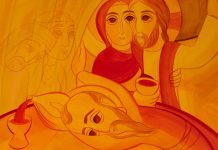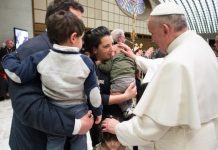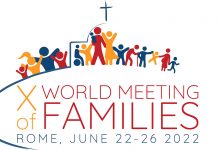According to nature the family in itself is part of existence. We know that even in the animal world there are families. Even birds and fish have families.
So the family expresses the way living beings exist; it is something that belongs to the nature of creation.
Nevertheless, for our faith, according to our Christian tradition, this is not the case because with Baptism we Christians receive a new life, a life not according to the existence of nature, but according to a life that belongs to God. God shares His way of being with us.
For us Christians, the family is the expression of a sacrament, which is Marriage. And this changes its meaning completely, because a sacrament always implies transformation. It is within natural life that the Holy Spirit brings about the transformation of the way of existence. And he does so by transfiguring natural life, not by denying it, but by embracing it and transforming it, because the primacy is no longer of nature, but of the relation.
So to set up this image, on the occasion of this great gathering of families, I thought about where I should start from.
What I felt was important was to show the novelty of the family according to the Church, according to Baptism, according to life in Christ, according to the new man.
Therefore, I remembered the great Syriac Church father St. Jacob of Sarug, who speaks of the “veil on Moses’ Face.”
St. Jacob wrote a beautiful homily in verse on the passage from the book of Genesis where it says that “God created man and woman” and then it says that “That is why a man leaves his father and mother and clings to his wife, and the two of them become one body” that is, one life, one flesh.
St. Jacob of Sarug says that Moses spoke, yes, of man and woman, but per se he looked into this reality: a deeper reality of which he dared not speak. For this reason, he placed a veil over it, so that no one could truly see what his eyes had beheld. Why? Because humanity was not yet ready to accept this great Mystery.
Since it is about man and woman coming together, I chose the image of the Wedding at Cana. We know from the wisdom texts – such as Sirach – that wine is what gives zest to life because wine is the love that embraces the meaning of human existence. So, in the episode of Cana, when Mary says “They have no more wine”, at that moment, Mary is actually saying to Christ: “These are newlyweds, but they have no more Love”.
And since the relationship between God and man was perceived in the man-woman image (just think of the Song of Songs), this passage shows that the relationship between man and God is worn-out, that is, it is no longer lived, it is no longer based on Love.
In fact, the patristic tradition interprets the six jars as the law of Moses, to be used for purification. However, the six jars are empty. Moreover, they are made of stone. Thus, in practical terms, in the episode of the Wedding at Cana an enormous step forward in the relationship between man and God takes place. A relationship based on the law that comes from the outside and that has progressively been read and understood in a moralistic way comes to an end, and a new relationship between God and man is revealed, a relationship between Father and Son, embodied by all those who make the life of the Son their own.
It is a relationship that is truly founded in Love and becomes an expression of Love.
So I took the image of Cana and turned to Jacob of Sarug.
Anyone who understands a bit of ancient Christian iconography will immediately recognize St. Paul in the face of this wedding servant.
Someone might say, “But what does St. Paul have to do with the Wedding at Cana, if Paul was not present at Cana of Galilee during the wedding?” It does, it does! Let’s see!
I would like to read some passages from Jacob of Sarug.
I said that Jacob veiled this image. In fact, Jacob says, “The prophet Moses introduced the story of the man and his wife / for through them one speaks of Christ and his Church. / With the enraptured eyes of prophecy, Moses saw Christ, / and how He and his Church would be one in the waters of Baptism; / he saw Him covered by her in the virginal womb / and she covered by Him in the baptismal water.”
This encounter is formidable! He is made flesh and, as the son of God, he becomes man to then reveal the man clothed with Christ in the baptismal waters.
“…the Bridegroom and the Bride have spiritually become one, / and it was of them that Moses wrote ‘The two shall be one’… Then Moses, evidently veiled, “saw Christ and called him man, / he also saw the Church and called her woman.” This is remarkable: he called man that which Christ was and the humanity assumed by Christ he called Church.
“And because the veil was stretched over it, / no one knew what that great painting was, or who it represented.”
But now comes the best part.
“After the wedding feast [thus after Christ’s Passover], Paul went in and saw / the veil spread out there, he took it and pulled it away from the beautiful couple. / In this way he uncovered and revealed to the whole world Christ and his Church / whom the prophet Moses had depicted in his prophecy. / The Apostle trembled and cried out, ‘This mystery is great,’ / and began to show what the covered painting was: / “In those called «man and woman» in the prophetic scriptures / I recognize Christ and his Church, the two who are one.” / The veil over Moses’ face has now been removed; / come all and see the glory that never fades away; / The great mystery that was veiled has now come to light. / May the wedding guests rejoice in the Bridegroom and the Bride, so beautiful. / He gave himself to her, born from a poor girl; / he made her his own, and she is bound to him and rejoices with him. / He has reached deep down and raised up the humble girl / for they are one, and where he is, there she is with him. / The great Paul, that great profundity among the apostles, / exposed the mystery, which is now clearly told. / The great beauty that had been veiled has now came into the open, / and all the peoples of the world saw its splendor. / The promised Bridegroom brought the daughter into a new womb, / and the Baptismal waters represented the birth and she was born: / He remained in the water and invited her: she went down, covered herself with Him and came back up; / she received Him in the Eucharist, and so the words of Moses that the two shall be one were proven. / From the water comes the chaste and holy union / of Bride and Bridegroom, united in spirit through baptism. / Women are not united to their husbands in the same way / as the Church is united to the Son of God. / What bridegroom dies for his bride, / except for our Lord? / What bride has chosen a slain man as her husband? / Who, since the beginning of time, has ever given his blood as a wedding gift, / except for the Crucified One, who sealed the marriage with his own wounds? / Who has ever seen a corpse placed in the middle of a wedding feast, / with the bride embracing him, waiting to be consoled by him? / At what wedding feast, except this one, did they break / the body of the bridegroom for the guests instead of other food? / Death separates wives from their husbands, / but here it is death that unites this Bride to her Beloved! / He died on the cross and gave his body to the Bride made glorious, / who embraces him and eats him every day at her table. / He opened his side and joined his cup to the holy blood / to give it to her to drink so that she might forget her many idols. / She anointed him with oil, covered herself with him in water, consumed him in the Bread, / drank him in the Wine, so that the world would learn that the two are one. / He died on the cross, but she did not replace him with another; / she is full of love for his death, knowing that she is given life from it.”
The concept that man and woman in the sacrament of Matrimony are grafted into the unity of the son of God with humanity, with the Church, is very strong. Never again is Christ without a body, but it is the body of glory, the risen body. Marriage is therefore a part of this indissoluble and unshakeable unity between God and man.
I would like to very briefly paraphrase St. John Chrysostom, who states something that perhaps could be challenged by so many today. He affirms that the Sacrament of Matrimony is a testimony as well for consecrated persons who follow the path of virginity. In fact, it attests to them what they might not grasp so straightaway, namely, that Matrimony is fulfilling and it is an expression throughout life and history of that unity of Christ with his Bride, of Christ with the Church. Consecrated people, therefore, through married couples, understand that they too, thanks to their baptismal vocation, share in this unity of Christ, the Son of God, and humanity.
I think that in our present historical context Nikolai Berdjaev has something truly great to say. He once wrote that in Christian traditions, Marriage has not been explored yet, because we have included it too quickly into family, however according to nature. I hope that, through this text and also through this small image, we can understand that for us Christians, the family is the expression of the Sacrament and that it has an ecclesial dimension, therefore it is inseparable from the Church. In it, the bond of blood cannot compete with our participation in the blood of Christ, even if it is easy for the blood according to nature to prevail and not the blood of the Eucharist. But, as another great father, Nicholas Cabasilas, puts it: “We are truly blood relatives of Christ.” Our parents gave us blood, but our blood is not the parents’ blood. As soon as they gave it to us, our blood is no longer theirs. While we are nourished by life, that is, by the blood of Christ that becomes ours.
Therefore, for Christians the family is an expression of the sacrament and of ecclesiality, and it indicates how in this world man lives when he is united with God. It becomes an expression of the divine humanity of Christ.
For the use of the image, please cite the author with the following: Work of Fr. Marko Ivan Rupnik, 2021
Download
28 july 2021














